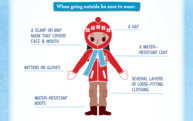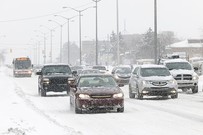
|
 If you’re cold, your pets are too! Make sure you keep your pets safe and warm this winter with these tips:
- Always bring your pets inside when temperatures are below freezing.
- Wipe off your dog’s paws after going outside in winter. Ice-melting chemicals can make pets sick.
- Don’t let pets lick antifreeze. Your pets may think it’s sweet, but it’s poisonous for them to eat.
- If you see pets wandering outside in cold weather, call your local animal control agency.
For more tips to keep your pets safe this winter, visit https://www.ready.gov/pet-toolkit. Join the conversation on social media with #PetPreparedness.
|
 The days are getting colder in much of the U.S. Do you know the health risks of cold weather? Hypothermia, which occurs when your body reaches an unusually low temperature, can be a risk in extreme cold. Here’s how to prepare for and prevent hypothermia:
- Don’t spend too much time outside in extreme cold.
- Make sure you wear layers of warm clothing if you need to go outside. Wear a scarf that covers your face and mouth, gloves, water-resistant boots, a hat, and layers of loose clothing.
- Know who is most at risk of hypothermia. According to the CDC, anyone exercising or spending time outdoors, babies sleeping in cold rooms, and older adults with inadequate food, clothing, or heating are at high risk.
- Get medical attention immediately if a person’s temperature is below 95°F.
To learn more about how to prepare for, recognize, and respond to hypothermia, visit https://www.cdc.gov/disasters/winter/staysafe/hypothermia.html.
|
 Are you traveling for the holidays? Whether you’re flying long distances, or just driving around town, use these travel safety tips this winter:
- Stay off the roads during winter storms.
- Keep an emergency kit in your car. Include jumper cables, warm clothes, bottled water, snacks, a spare cell phone charger, blankets, flares, and an ice scraper.
- If you’re traveling by plane for the holidays, review TSA's security screening tips.
- If you’re traveling with pets, pack something familiar like a toy or blanket to help lower stress.
For more holiday travel tips, visit https://www.ready.gov/holiday-toolkit. Join the conversation on social media by using #TravelSafety.
|
January 1—New Year’s Day: Resolve to be Ready. In 2019, make a resolution to be prepared. The Resolve to be Ready Social Media Toolkit has practical preparedness tips for individuals, families, businesses, and other organizations. Find it here: https://www.ready.gov/NewYears.
Disclaimer: The reader recognizes
that the federal government provides links and informational data on various
disaster preparedness resources and events and does not endorse any non-federal
events, entities, organizations, services, or products. Please let us know
about other events and services for individual and community preparedness that
could be included in future newsletters by contacting FEMA-prepare@fema.dhs.gov.
|

|